#.32 acp
Video
youtube
Minute of Mae: Astra 300
#youtube#c&rsenal#candrsenal#minute of mae#oldguns#old gun show#spanish guns#atra pistol#astra 300#.380 auto#.380 acp#.32 acp#pocket pistol
3 notes
·
View notes
Note
Hi John! You were able to answer a question like this before, about what kind of gun Ellie uses in TLOU.. do you know what Frank's gun is that she takes from the last episode? Thank you!!
Hello anon! Are you the same one that asked me about the weapons in TLOU Part II a couple years ago, lmao. Happy to be your resource.
Frank's gun that Ellie takes is undoubtedly a Beretta 70. It's a v famous little gun, and Bill is wild fucking Guns & Ammo subscriber, so it like makes extra sense that he'd have it and appreciate owning an early example of the model. You can tell it's that early model because it has a cross-bolt safety behind the Beretta stamp rather than a lil' thumb flip safety. Here's a comparison of what Ellie is holding in the episode and that gun:
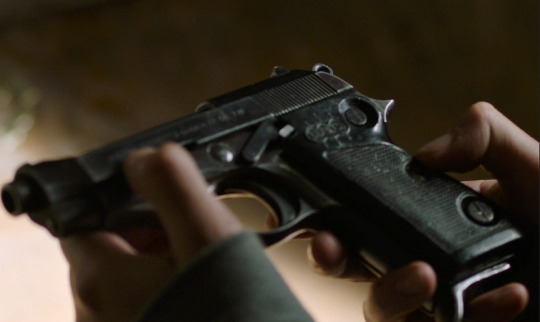

#i'm not bill i promise lmao#berettas are class tho#70 = def 32 ACP too#v appropriate for your partner who doesn't know guns or a 14 year old girl in the fungi apocalypse#lol
4 notes
·
View notes
Text


Astra 3000 semi automatic pistol, .32 ACP, Spain, manufactured in 1952.
from Hermann Historica
259 notes
·
View notes
Text
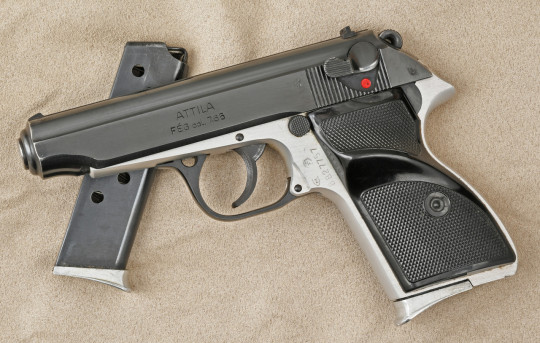



FEG PA-63 ATTILA
3.9'' barrel, FEG MODEL PA-63 ATTILA SEMI AUTO PISTOL CHAMBERED IN 32 ACP
19 notes
·
View notes
Text



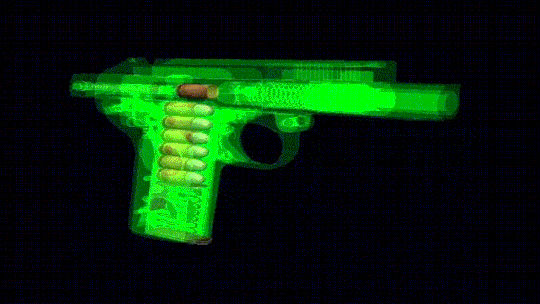
The Dreyse Model 1907 is a semi-automatic pistol designed by Louis Schmeisser. The gun was named after Nikolaus von Dreyse, the designer and inventor of the Dreyse Needle Gun. .32 ACP.
I added the GIF to show the somewhat unusual operation of the weapon.
53 notes
·
View notes
Text
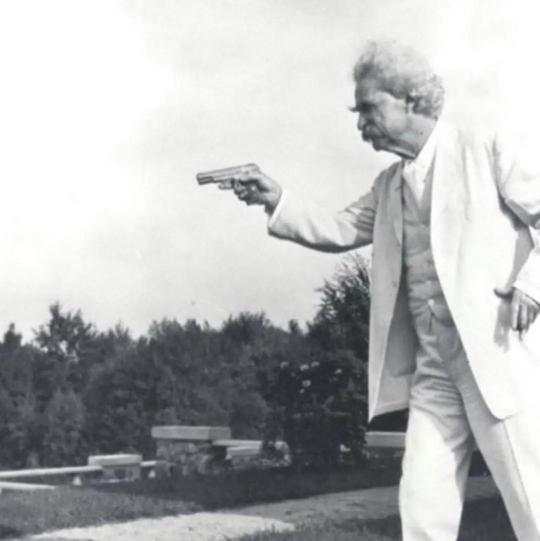
This is cool, Mark Twain with his Colt 1903 32 ACP pistol in Carson area in 1908
72 notes
·
View notes
Text

Today’s disabled character of the day is Loid Forger (Twilight) from Spy X Family, who has an unspecified trauma disorder and Irritable bowel syndrome
Requested by Anon
[Image Description: Drawing of a man wearing a complete green suit with a red tie, silver watch, dagger shaped lapel pin, and black socks, gloves, and loafers. He has blond brushed back hair and blue eyes. He's sitting in a Grand Confort LC-2 Petit Modèle armchair , holding a newspaper titled Daily Ost in his right hand, and a Walther PP, other side - .32 ACP pistol in his left.]
#unspecified character#tw gun#Spy X Family#Spy X Family twilight#Spy X Family loid forger#loid forger#disabled character of the day#IBS character
103 notes
·
View notes
Text
US General Officer's Handgun
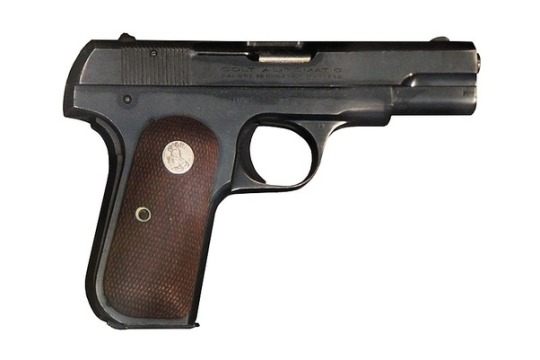
I will drag an e-mail discussion here to the blog. The question was outside of General George Patton who had his own ideas about side arms, what did US general officers carry (if anything) during World Wars I, II and the Korean War. There is an answer because the US Army issued them to general officers in particular.
The Colt Pocket Hammerless, either the Model of 1903, in .32 ACP, or the Model of 1908, in .380 ACP.
Let's face it, the general can carry what general wants to carry, but the fact that there was an issue firearm for generals meant that many of them who carried likely carried that.
Moving on to Patton. General Patton's daily carry handguns were fitted with ivory grips. “Pearl handles are for New Orleans pimps.” the General famously quipped to a reporter.
Although popularly remembered as the "two-gun" General, Patton actually seldom wore both of his "carrying guns" together. The handguns most associated with him, and which are now in the Patton Collection of the West Point Museum, are a .45 Long Colt Single Action revolver, 1873 Army Model, and a .357 Magnum Smith & Wesson revolver.
Of the two of them, aides and relatives have said that the .45 Colt was the one Patton stressed for everyday carry, while the .357 was to be the "killing gun," in his words if the battlefield situation ever demanded it. The .45 was his oldest companion, having been purchased in 1916. There are two notches filed in the left-side ivory grip of the highly engraved .45. They came to be through a 1916 gunfight that took place in Mexico where he killed two Mexican irregular officers.
As a young officer, George Patton was part of General Pershing’s punitive expedition into Mexico to hunt down Francisco (Pancho) Villa, Governor of Chihuahua. On 14 May he came under fire while leading a caravan of three vehicles to obtain food for his troops.
Patton was armed with his own Colt SAA .45 revolver. During the fight, he emptied the weapon as many as three times. In a letter to his father after the fight, Patton wrote, “I fired five times with my new pistol and one of them ducked back into the house. I found out later that this was Cardenes and that I had hit both him and his horse.” Captain Julio Cardenes was second in command under Villa when he was shot by Lieutenant George S. Patton.
Thereafter, Patton carried a second, or backup, handgun. General Joyce confirmed that the experience with the Mexican gangsters convinced Patton he should carry at least two handguns. Patton learned through experience as did we all that two is one and one is none.
16 notes
·
View notes
Photo



AUSTRO-HUNGARIAN WW1 WEAPONS
Shoutout To @lilis-palace & @chere-indolante For Making Such Great WW1 Uniform
Download Link Here
Note: While in reality The Astro-Hungarian Empire Weapons during the Great War Are Hodgepodge of Armament With German Empire weapons that Covered in our Previous Post. This Post Was covering the Homegrown Weapons From Astro-Hungarian Empire that used During WW1 Despite one of them Are Never Actually Exist in Real life.
Mannlicher M1895
The Mannlicher M1895 is an Austro-Hungarian bolt-action rifle, developed and designed by Ferdinand Ritter Von Mannlicher. It features a straight-pull bolt-action feeding from single-column magazine fed by en-bloc 5-round clips. The long rifle features a 30.1" barrel, and the carbine a 19" barrel. Both rifle and carbine feature a single-piece stock with full-length handguard. It fires the 8x50mmR cartridge. The rifle was produced at Österreichische Waffenfabriks-Gesellschaft, Steyr, from 1896 to 1918, and Fegyver és Gépgyár Rt. ("Arms and Machine Manufacturing Company") in Budapest from 1897 to 1918. Over 3,000,000 rifles were produced, roughly 75% at Steyr. Bulgaria purchased many M95s, beginning in 1903. It was the primary battle rifle of the Austro-Hungarian Landwehr and the Bulgarian Army during World War I, and continued to serve the postwar Austrian, Hungarian, and Bulgarian armies. Atleast until World War II
Frommer Stop
The Frommer Stop is a semi-automatic pistol produced in 1912 by Fegyver- és Gépgyártó Részvénytársaság ("Arms and Machine Manufacturing Company") Known As FÉG of Hungary. It was used throughout World War I and World War II by the Hungarian Armed Forces. Designer Rudolf Frommer adapted the design from another pistol that fired .32 ACP (7.65mm) from a seven-round detachable magazine. The weapon is unusual among automatic pistols in using a long-recoil system of operation. The Frommer Stop was available in 2 proprietary cartridges, similar to the .32 and .380 ACP, respectively. However, the Stop's cartridges had more powder and fired a heavier bullet. The Stop could fire regular .32 and .380 rounds, though, with less reliability.
The Standschütze Hellriegel 1915
The Hellriegel 1915 is a prototype water-cooled submachine gun for or by the Austro-Hungarian reserves (Standschützen) during World War I, by a designer identified only as "Hellriegel". The weapon could be fed from either box magazines or chute-fed.
A highly obscure weapon, no complete examples are known to still exist, no documentation remains, the only remaining evidence being three photographs dated October 1915 depicting the weapon being tested. As a result, its operating mechanisms and development history are pure speculation. Its apparent automatic fire capability and pistol caliber would make it one of the earliest sub machine gun designs in history.
@ts4-poses @ts4-poses-masterlist
#TS4#ts4cc#ts4 cc#thesims4#the sims 4#TS4WEAPON#ts4military#the sims 4 weapon#the sims 4 gun#the sims 4 military#ts4 historical#Decade Challenge#sims 4 decades#the sims 4 decades challenge#the sims 4 custom content#the sims 4 cc#history#ww1#ts4 WWI
95 notes
·
View notes
Note
If you were a traveler in the world of Kino's journey, what method of transportation, weapon, and quirky companion would you bring? (Maybe a combination of two or more). Be indulgent!


The ideal vehicle would definitely be a honda super cub, but with the 124cc engine, followed only by the Ural because it was my dream motorcycle for a while (I'm eternally appalled at how expensive archaic soviet tech that hasn't changed since the 30s is in the US).
The weapon choice, it's almost embarrassing how much deliberation this gave me. I'm going to take the cop out approach and make a loadout for each bike respectively. For the Honda: Bodeo 1889 and a Beretta Tomcat in .32


For the Ural: Steyer-Hahn 1912 with the stock holster and in 9mm para like the wehrmacht rechamberings, the Tula-Korovin in .25 acp, and MAT-49 to stow on the bike



Idk about a companion though, I've never been a big fan of animals but having a human companion would ruin the vibe. I'd want something like a ghost, or a mental apparition that appears only in my vision and gives be conflicting and condescending advice.
#lurklore#if i were to fulfill my status as a fencer and take a sword it would be an epee de cour but sans any ornamentation
23 notes
·
View notes
Text

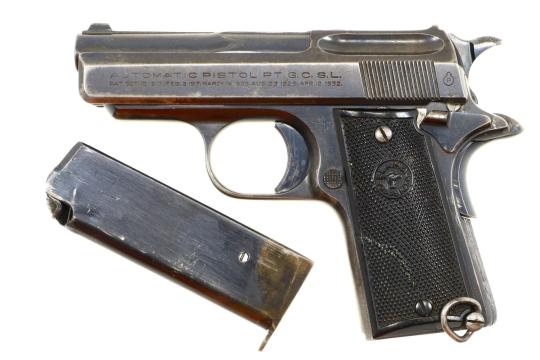
1933 Gabilondo y Cia "Llama" Pocket Pistol in 7.65x17mm (32 ACP)
love this handgun, just something about spanish guns produced during the period between the 1900s and 1930s
9 notes
·
View notes
Text
youtube
The media's guide to firearms calibers in the U.S.
5.56mm NATO on the right down to the Thomas Jackson Rodman ship killer 20" cannonball of 1864 on the left.
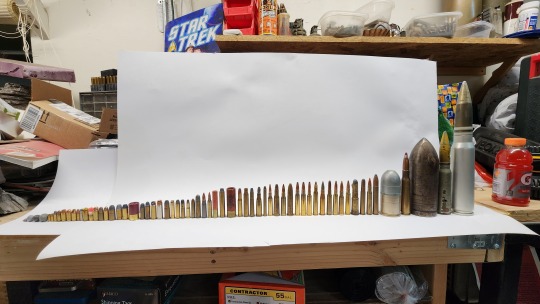
For the rest of us, the list of actual types of cartridges is as follows:
30mm, 20mm, 2” cannon shell, .50 BMG, 40mm Grenade, 458 Winchester Magnum, 30-06 Tracer, 35 Winchester, .577/450 Martini-Henry (Coiled brass case.), 7.7x 58 JAP, 7.62x54 heavy Ball, 7mm Mauser, 7mm, 8x56RS, 30-06 Accelerator, 6.5x55 Swedish, 8mm Mauser, 303 British, 50-90 Sharps, .308, .348 Winchester, 6.5x50 JAP, 25-25, 8mm Lebel, 32-40, 30-06 Blank, 30-30, 12 Gauge, .444 Marlin, .410, .223, 7.62x39, 401 SLR Winchester, 30 Carbine, 25-20, 32-20, .357 Magnum, .44 Magnum, .44 SPC, .38 SPC, .38 Long, 12 Gauge Short, .44 Russian, .45 ACP, .45 Auto Rim, 9mm Luger, 30 Luger, .40 Cal, 9mm Simunition, .45 shot shell, .22 Long Rifle shot shell, .22 Long Rifle, .380 Auto, .380 Auto, 9mm Makarov, 25 Auto, .22 Long, .22 short, .22 Short blank, .50 cal ball, .44 cal ball, .36 cal ball, .177 pellet, .177 BB
*.380 auto is there twice I knocked it over once and picked up 2 .380's when I thought I'd put up a .380 and a .32 auto. I could have put a dozen more cartridge's up there but ran out of room.
28 notes
·
View notes
Text


Austrian Mannlicher Model 1905 semi automatic pistol in .32 ACP
from Hermann Historica
165 notes
·
View notes
Text




ROYAL BREVETE
32 ACP; 3 3/8'' barrel, Marked on the left side of the slide "FABRIQUE D'ARMES DE PRECISION / PISTOLET AUTOMATIQUE ROYAL BREVETE S.G.D.G. (CAL. 7.65m/m)".
10 notes
·
View notes
Text
Presenting perhaps the only two good Italian small arms of World War 2: the Beretta Model 1923 pistol and the Beretta Model 38A submachine gun.


The Model 1923 was a blowback operated pistol in the 9mm Glisenti cartridge. 9mm Glisenti was, essentially, 9mm Luger down-loaded by about 25%, allowing it to function safely in a blowback operated action. It was still a perfectly serviceable cartridge for the day, and was in many ways better than the .380 ACP it was semi-replaced by for the Italian Army; it was miles ahead of the .32 ACP favored by the Italian Air Force and Navy. The Model 1923 was a quality pistol with a (for the time) perfectly servicable 7 round magazine.
The Beretta Model 38A submachine gun was and is considered, by some, the best submachine gun of World War 2. Firing a specially up-loaded M38 9mm Luger cartridge at a rate of fire of 600 rounds per minute, the gun's built-in compensator and general heft meant it had little recoil and very little movement of its sight picture, even during full auto fire. It became a weapon that was liked by everyone who used it - the Royal Italian Army, the Italian resistance, the Germans, the Romanians, the Bulgarians, the Romanians, the Argentinians, the Ethiopians, the Greeks, Yugoslavian and Albanian partisans.
In modified form, it found even more success after the war, being used by dozens of nations.
2 notes
·
View notes
